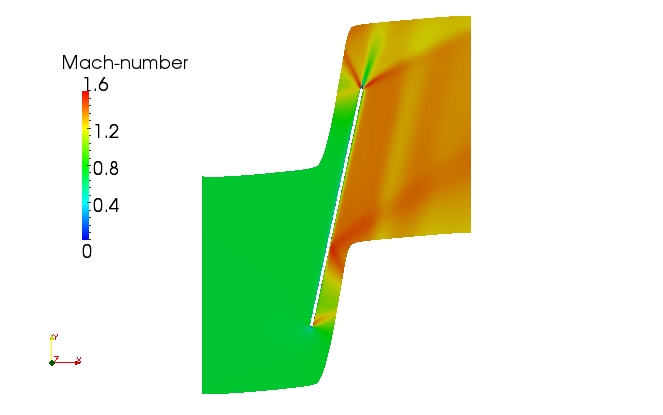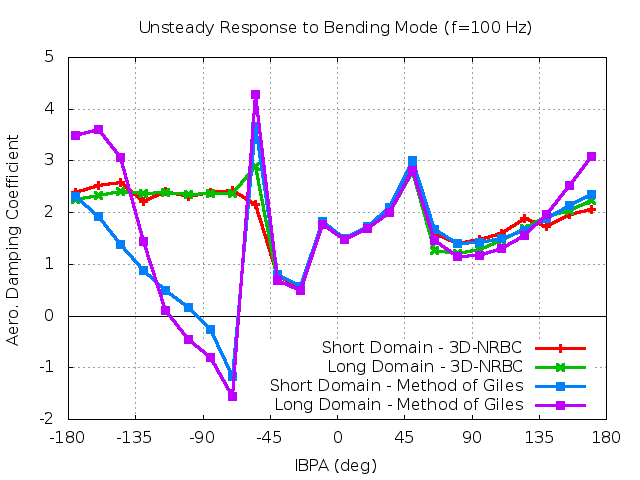RPMTurbo has recently developed a simple flutter test case which clearly demonstrates
why RPMTurbo's non-reflecting boundary condition is the best.
The geometry and flow conditions for the test case are similar to those
of a typical industrial steam turbine near the tip.
The tip region is critical for flutter analysis because this is where
most of the unsteady aerodynamic work that drives flutter occurs.
RPMTurbo's LUFT code is currently the only CFD method that can
calculate the correct solution for this problem because it is
the only method that considers the non-uniform flow
in the pitchwise direction when applying the non-reflecting
boundary condition at the inlet and the outlet.
The geometry for the new test case is a 2D cascade of flat plates with
half circles at the leading and trailing edge and a high stagger angle (78 degrees).
The isentropic Mach number at the turbine exit is high (1.36) and there
are shocks present in the channel and downstream of the trailing edge
(flow field shown below).
A complete description of the geometry and flow conditions
can be found on RPMTurbo's website.

Steady-state Mach number for 2D steam turbine test case
The aim of the test case is to calculate the
flutter stability (aerodynamic damping)
due to a blade vibrational mode normal to the blade
(similar to a 3D bending mode).
A plot of aerodynamic damping versus inter-blade phase angle
calculated by RPMTurbo's LUFT code is shown below.
Solutions were calculated on short and long domains and with RPMTurbo's
3D non-reflecting boundary condition (3D-NRBC) and Giles' 2D non-reflecting boundary condition.
The short domain has the inlet and outlet planes closer to the blade.
The solutions should be independent of the location of the inlet and the outlet
if the non-reflecting boundary condition is working correctly.
Only the solutions calculated with RPMTurbo's 3D-NRBC are
independent of the inlet and outlet location.

The method of Giles fails for this test case because it assumes that the steady flow
is uniform at the farfield and that the unsteady aerodynamic modes are harmonic.
RPMTurbo's 3D-NRBC determines
the shape of the unsteady aerodynamic modes by
taking the variation in the steady flow at the outlet into consideration.
The shape of the aerodyamic modes can be non-harmonic if the steady flow is
not uniform and it is necessary to calculate the correct aerodynamic modes
in order to apply the non-reflecting boundary condition correctly.
RPMTurbo's 3D-NRBC is the only non-reflecting boundary condition that considers the variation of
the steady flow in the pitch-wise direction.
The long and short domain meshes used by RPMTurbo for this test case
are available at the RPMTurbo website.
Are the results of your flutter analysis method independent of the far-field location?
If they are not then they are wrong and you should contact RPMTurbo.
While challenging, this new test case is only 2D and industrial cases are 3D.
The application of RPMTurbo's 3D-NRBC to a 3D problem is discussed in the next article (below).